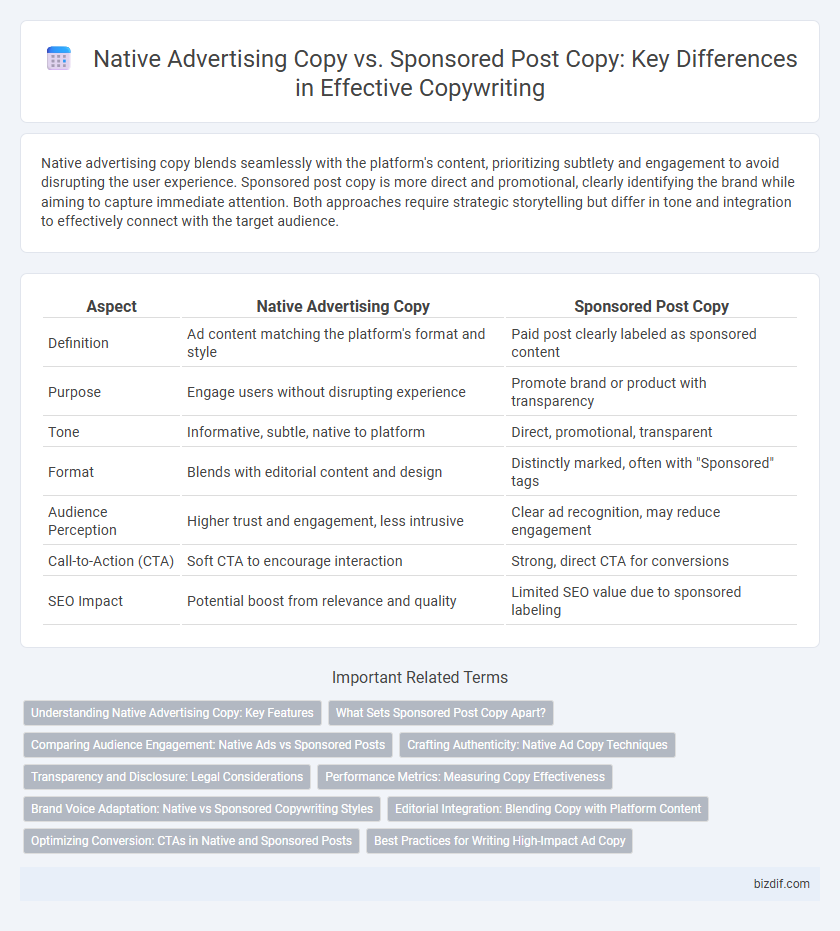Native advertising copy blends seamlessly with the platform's content, prioritizing subtlety and engagement to avoid disrupting the user experience. Sponsored post copy is more direct and promotional, clearly identifying the brand while aiming to capture immediate attention. Both approaches require strategic storytelling but differ in tone and integration to effectively connect with the target audience.
Table of Comparison
| Aspect | Native Advertising Copy | Sponsored Post Copy |
|---|---|---|
| Definition | Ad content matching the platform's format and style | Paid post clearly labeled as sponsored content |
| Purpose | Engage users without disrupting experience | Promote brand or product with transparency |
| Tone | Informative, subtle, native to platform | Direct, promotional, transparent |
| Format | Blends with editorial content and design | Distinctly marked, often with "Sponsored" tags |
| Audience Perception | Higher trust and engagement, less intrusive | Clear ad recognition, may reduce engagement |
| Call-to-Action (CTA) | Soft CTA to encourage interaction | Strong, direct CTA for conversions |
| SEO Impact | Potential boost from relevance and quality | Limited SEO value due to sponsored labeling |
Understanding Native Advertising Copy: Key Features
Native advertising copy seamlessly integrates with the platform's content, using language and visuals that match the editorial style to enhance user engagement without disrupting the experience. It prioritizes authenticity and relevance, ensuring the message aligns with the audience's interests while subtly promoting the brand. Effective native advertising copy also employs storytelling techniques and value-driven content to build trust and encourage interaction.
What Sets Sponsored Post Copy Apart?
Sponsored post copy is distinctly designed to blend seamlessly with the platform's organic content, creating a less intrusive reader experience. It often leverages storytelling techniques and brand voices more deeply aligned with the audience's expectations on that specific channel. Unlike typical native ads, sponsored posts provide greater flexibility in format and depth, enhancing engagement through authentic and contextually relevant messaging.
Comparing Audience Engagement: Native Ads vs Sponsored Posts
Native advertising copy typically generates higher audience engagement by seamlessly blending with platform content, creating a more organic and less intrusive user experience. Sponsored post copy often stands out as promotional, which can result in lower click-through rates and reduced reader trust. Data from marketing studies show native ads achieve up to 53% higher engagement compared to sponsored posts, highlighting their effectiveness in capturing audience attention.
Crafting Authenticity: Native Ad Copy Techniques
Native advertising copy leverages seamless integration with platform content by mirroring tone, style, and user intent, enhancing perceived authenticity and engagement. Techniques include storytelling, using relatable characters, and avoiding overt sales language to build trust and maintain reader interest. Employing data-driven insights to tailor messaging ensures the copy aligns with the audience's preferences, boosting conversion rates effectively.
Transparency and Disclosure: Legal Considerations
Native advertising copy must adhere strictly to transparency and disclosure guidelines set by regulatory bodies like the FTC to avoid misleading consumers, clearly labeling content as paid or sponsored. Sponsored post copy often requires explicit disclosure, such as hashtags (#ad, #sponsored) or disclaimers, to maintain legal compliance and brand integrity. Failure to properly disclose native or sponsored content can result in regulatory penalties and damage to consumer trust.
Performance Metrics: Measuring Copy Effectiveness
Native advertising copy often delivers higher engagement rates due to its seamless integration with platform content, resulting in increased click-through rates (CTR) and time on site. Sponsored post copy may generate broader reach but typically shows lower conversion rates and less user interaction compared to native ads. Tracking performance metrics such as CTR, conversion rate, bounce rate, and return on ad spend (ROAS) provides critical insights into the effectiveness of each copy type for optimizing future campaigns.
Brand Voice Adaptation: Native vs Sponsored Copywriting Styles
Native advertising copy seamlessly integrates brand voice with the surrounding content, creating a subtle, organic connection that resonates with the audience without disrupting their experience. Sponsored post copy maintains a more overt promotional tone, directly reflecting the brand's core messaging while clearly distinguishing itself as paid content. Both styles require careful brand voice adaptation to balance authenticity and marketing objectives within their respective formats.
Editorial Integration: Blending Copy with Platform Content
Native advertising copy seamlessly blends with a platform's editorial style, matching tone, format, and user expectations to enhance authenticity and engagement. Sponsored post copy maintains a clearer boundary between ad content and editorial material, often designed to stand out while still aligning loosely with the platform's voice. Effective native advertising relies on subtle editorial integration to increase trust and reduce disruption in the user experience.
Optimizing Conversion: CTAs in Native and Sponsored Posts
Crafting effective CTAs in native advertising copy involves seamless integration with the content style and audience intent, enhancing user engagement and trust. Sponsored post copy requires clear, direct CTAs that align with the post's promotional nature, driving immediate action without disrupting user experience. Optimizing conversion rates depends on tailoring CTA language and placement to the specific format's engagement patterns and user expectations.
Best Practices for Writing High-Impact Ad Copy
Native advertising copy seamlessly integrates brand messaging with editorial content, prioritizing authenticity and relevance to engage the target audience effectively. Sponsored post copy, while still persuasive, leans more on clear brand promotion and call-to-action clarity to drive conversions. Best practices include focusing on audience-centric language, maintaining tone consistency with the hosting platform, and crafting concise, value-driven headlines to maximize ad impact and user engagement.
Native Advertising Copy vs Sponsored Post Copy Infographic

 bizdif.com
bizdif.com